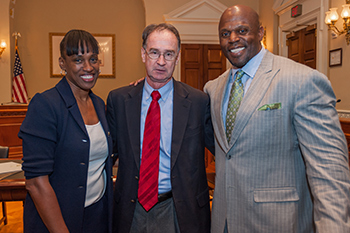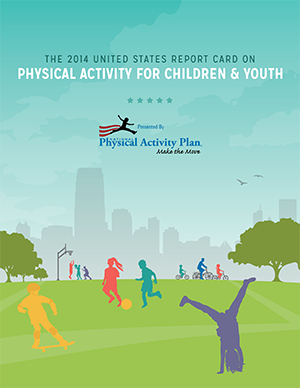Arnold School researcher: Overall physical activity is D-
May 6, 2014
Dr. Russ Pate spoke at a briefing in Washington, D.C., on the state of physical activity among children and youth in the United States. The first-ever report card shows much need for improvement.
The nation has received its first report card evaluating physical activity among children and youth, and Uncle Sam could not possibly be proud of the 2014 grades.
The bearer of the news was Dr. Russ Pate, a professor of exercise science at the Arnold School of Public Health and one of the world’s leading researchers on physical activity interventions in children and adolescents.
"I often say that if you ask world leaders in this area to name the top researchers in this area, Russ will be one of the first two or three mentioned," said colleague Dr. Steve Blair, a researcher and professor in the Department of Exercise Science and the Department of Epidemiology and Biostatistics.
Speaking at a Congressional Fitness Caucus briefing on Capitol Hill on April 29, Pate revealed that 50 percent of children and youth are spending their waking hours in sedentary activity.
"This percentage rises with age," said Pate, chairman of the National Physical Activity Plan (NPAP) Alliance.
"Physical activity levels in American youth fall far below the recommended level, with only about one quarter of children aged 6 - 15 meeting the current guideline of 60 minutes of moderate physical activity per day," he said.
The United States Report Card on Physical Activity for Children and Youth was developed by the NPAP Alliance in collaboration with its organizational partner, the American College of Sports Medicine (ACSM).
Dr. Peter Katzmarzyk, chairman of the 2014 Report Card Research Advisory Committee, said the primary goal of the Report Card is to assess levels of physical activity and sedentary behaviors in American children and youth, facilitators and barriers for physical activity and related health outcomes.
“We hope the Report Card will galvanize researchers, health professionals, community members, and policy makers across the U.S. to improve our children’s physical activity opportunities, which will improve health, prevent disease and disability, and enhance quality of life,” said Katzmarzyk, the Associate Executive Director for Population and Public Health Sciences at Pennington Biomedical Research Center at Louisiana State University.
The key indicators that were evaluated and graded as part of the U.S. Report Card include:
- Overall Physical Activity: D-
- Sedentary Behaviors: D
- Active Transportation: F
- Organized Sport Participation: C-
- Active Play: INCOMPLETE
- Health-Related Fitness: INCOMPLETE
- Family and Peers: INCOMPLETE
- School: C-
- Community and the Built Environment: B-
- Government Strategies and Investments: INCOMPLETE
U.S. Rep. Ron Kind, D-Wis., who is the Fitness Caucus co-chair with U.S. Rep. Aaron Schock, R-Ill., said the report "illustrates the immediate need for a comprehensive action plan to promote physical fitness for our young people."
"It's hard to develop a healthy mind without a healthy body, and encouraging healthy habits and routines early in life is something we all can do to help our kids succeed in school and their communities," he said. "That's why I'm working on a bipartisan basis with Congressman Schock and others to make the healthy choice the easy choice for our children."
Dr. William Dexter, president of ACSM and director of the Sports Medicine Program at Maine Medical Center, discussed some constructive calls to action for policymakers and said that government has an important role to play in surveillance, research and other policies.
"Another important opportunity for improving physical activity grades in the United States is the role that physicians can play in encouraging kids and families to be more physically active," he said.
"ACSM launched a program called Exercise Is Medicine with the American Medical Association, and it encourages doctors to discuss physical activity during every patient visit. As a physician, I can tell you that I make physical activity an important part of my practice, and more and more doctors are going to be prescribing healthy and enjoyable physical activity for all Americans, and especially our youth," said Dexter.
The findings of the national Report Card on Physical Activity for Children and Youth are "deeply troubling," said Schock.

Dr. Russ Pate spoke at a Congressional briefing on the status of physical activity and youth. He was joined by Ken Harvey, four-time Pro Bowl Washington Redskins linebacker, and Jackie Joyner-Kersee, Olympic gold medalist.
"But we may have caught ourselves in enough time to change course. America's children deserve a future that is free from preventable chronic diseases such as heart disease and diabetes," he said. "The report card illustrates the need to promote physical fitness among America's youth, and I look forward to working with my colleagues and our non-profit allies on this issue to make sure next year's report shows measured progress among every key indicator."
Among those at the news conference were Ken Harvey, four-time Pro Bowl Washington Redskins linebacker, Jackie Joyner-Kersee, Olympic gold medalist, and representatives from SHAPE America, the largest organization of professionals involved in physical education, physical activity, dance, school health and sport -- all specialties related to achieving an active, healthy lifestyle.
Visit http://www.physicalactivityplan.org/reportcard.php to read more of the findings presented in the report.



_01.jpg)
_02.jpg)
